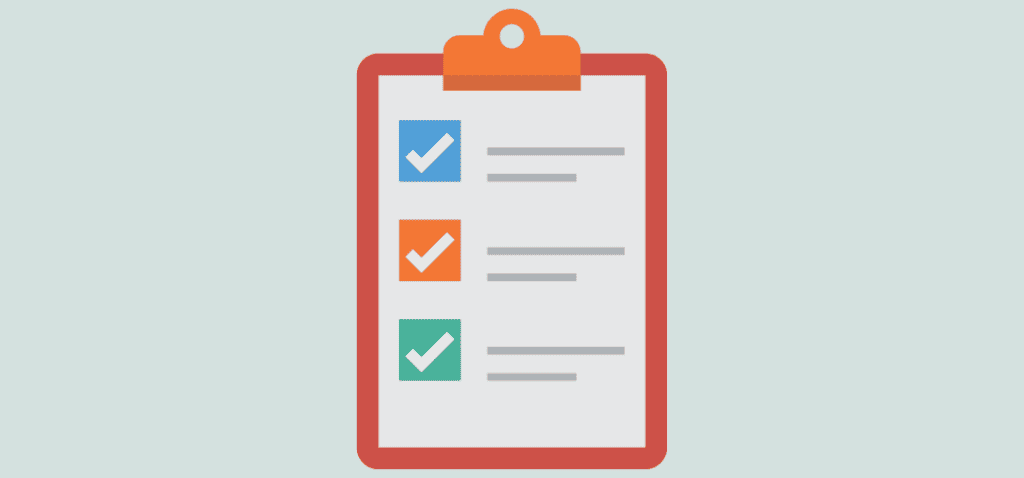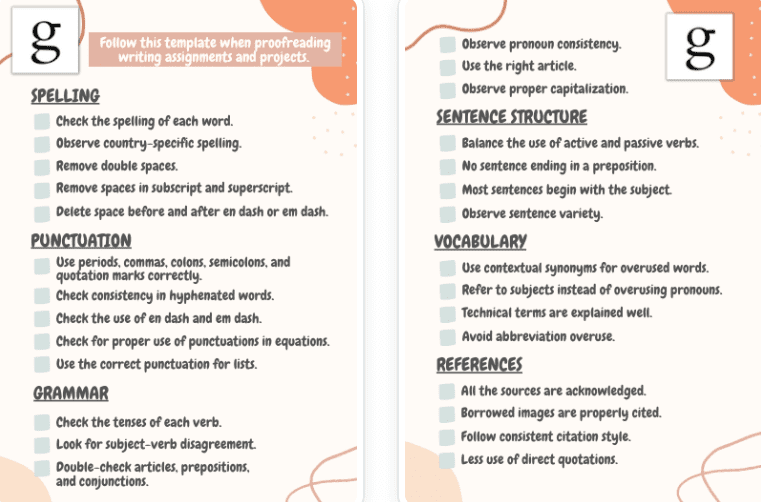Proofreading your work can be challenging because of the multiple writing mistakes to check. One way to ensure you’ve rummaged around all the errors is by having a proofreading checklist or template.
We’ll discuss 12 essential things to look for when you’re proofreading. I also created a proofreading checklist which you can download as a guide to publishing excellent content.
How to Create a Proofreading Checklist
There is no one way to create a proofreading checklist. Some proofreaders depend their list on the type of document. Others make a one-size-fits-all checklist that focuses on common mistakes.
Take your grammar skills to the next level
Take Our Copyediting Course
Proofreading Checklist Based on Document Type
Your proofreading checklist can differ based on the type of text you’re checking. Beyond the common mistakes in spelling and grammar, you’ll also find unique, genre-specific errors in each document.
If you’re proofreading a fiction manuscript, there are specific errors you should watch out for that are uncommon in non-fiction. For example, you might find dialogue tags in a short story or novel but not in an educational textbook.
Fictional works are also full of overly complex language and inconsistency of organizational pronouns. You also need to ensure the writer’s point of view stays consistent unless the story changes perspectives in every section.
Common errors in non-fiction manuscripts include improper use of “which” and “that” and place names. Proofreading non-fiction also requires the deletion of complex jargon and non-standard English.
If you’re proofreading online content, you should also check internal and external links and the formatting. Some online proofreaders also get training in SEO to double-check the use of keywords.
Proofreading Checklist Based on Common Errors
You can also create a general proofreading checklist for all types of writing. This time, you can focus on what to look for or the most common errors your writers encounter. One common writing error that even experienced writers have are homophones.
If you don’t know, homophones are words with the same sound but have different meanings and spellings. Double-check their use of “bare” and “bear” or “by” and “buy.”
Another common mistake among writers is inconsistency. In one sentence, they might write dates as “4 July, 2016” and “July 4th, 2016” in another. Inconsistencies also occur in heading capitalization, American and British English, symbols, and quotation marks.
Make sure you also have a sharp eye for double or missing words. It’s easy to miss a “the” in a sentence because our minds automatically read them. Our minds also skip repeated words in the sentence when the statement is predictable.
Your Essential Proofreading Checklist

There are a few aspects to consider when you’re proofreading. Here’s what to look for when polishing the text before publication.
1) Tone
The tone of writing is essential, especially if it’s a business, legal, or other forms of professional document. It reflects the writer and brand’s personality, affecting how the reader makes sense of the message.
Your tone is easier to convey if you’re a speaker with non-verbal cues and inflection. How can you inject these into writing? First, know your intention and audience.
As a proofreader, you should know to whom the writing is addressed. Suggest ways to match the reader’s needs in the most effective communication possible. Strive for your tone’s sincerity and confidence so your audience will trust you.
Numbers are one way to provide clear statements that will compel readers. Avoid commas in long sentences and the word “just” so you can sound more confident.
2) Product and Persona Positioning
Product and persona positioning is usually not the proofreader’s job. But if you work in advertising, marketing, or PR, you should take this aspect seriously.
If the document is a script for a product launch, the proofreader must ensure it aligns with the marketing efforts. A positioning statement should be clear, substantial, and specific. Define who the brand is serving, what they offer, how they offer it, and what makes them different from others.
Writers can try using a positioning template, or they can craft their own. The key is to answer “what, how, and why.”
3) Logical Flow
Logical flow considers the bigger picture of the manuscript so that the audience reads it smoothly. Analyze the flow in terms of sentences, paragraphs, and chapters. Position yourself as a reader before a proofreader. Can you follow the writer’s thoughts effortlessly?
A full-stop punctuation mark is not always enough to show the end of a statement. Sometimes, you must use transitional devices to move on to the next.
Logical flow also refers to the continuity of ideas throughout chapters. Suppose you’re proofreading an essay on media literacy, and the writer only defined the concept in the middle of the article.
It would help if you suggested putting the meaning of media literacy in the beginning. Doing so will help readers understand the following sections: the importance of media literacy, applications of media literacy, etc.
4) Grammar
Grammar is a “surface error” that proofreaders check on all types of documents. Shifting verb tense is one thing to look for that might confuse your reader. The subject-verb agreement also matters in every clause.
The best way to evaluate verbs in your writing is by encircling them all. Look at verbs in sequence, then check for errors. Does it use the correct perfect or progressive tense? Which linking verb is better? If you have a long subject, ensure you know the simple one.
You also want to see if each pronoun agrees with the antecedent. Never use “they” to replace a company name. Instead, use “it.” Know that “each,” “neither,” “either,” and “one” are singular pronouns.
Sentence fragments, run-on sentences, and comma splices also fall under grammar. Suggest ways to rewrite these statements so the message becomes more precise and leaves the content squeaky clean.
5) Style Guide Consistency
A style guide is a tool that has all the rules and guidelines for writing. Many companies produce their style guide to convey a single tone and voice in their documents. It shows a unified presence of the brand for individuals and groups who want to engage with them.
For example, NASA’s style guide focuses on using an educational tone. It uses The Chicago Manual of Style, then lays out its grammar, spelling, and naming rules. NASA also has a non-gender-specific section in its style guide.
6) Country-Specific Spelling and Jargon
Whether you’re a local, national, or international writer, your spelling and terminologies always need to be specific. British people may still read your content in American English even if you use “attorney” instead of “solicitor.” The secret is to stay consistent but understandable.
Even if you use industry terms, make sure it will make sense to an audience from a different industry. This rule is essential, primarily if you sell a product or service worldwide. You do not want people to exit your website because they do not understand your messages.
Try providing context when using industry jargon. It can be as simple as using the whole word instead of the acronym. “Search engine optimization” will give your readers a clue about your blog post. In the following sentences, you may start saying, “SEO.”
7) Logical Images
If the book or blog post includes images, ensure they are sensible for the readers. Some people only scroll through your post without reading the whole thing. Make the most out of the pictures to communicate your message.
Stock photos usually show poor communication. Swap it out for something more targeted. Or better yet, remove all the images that do not have value.
Providing labels for your images is also a must. Add a small caption at the bottom for readers to understand what the photo is all about.
8) Data and Image Attributions
Whether you’re proofreading a printed document or online content, data and image attributions are essential. Check if the author uses proper citations for every statement depending on the citation style.
Does it have the correct year and page number? For parenthetical citation, is the period outside the parentheses? Check the spelling of the source if it’s accurate.
If you’re editing a blog post, you can attribute information by linking them. For example, you can add a URL to the text “2018 study” so that readers can click on the study you’re referring to. To cite someone’s content on Twitter, you can include “via @username” in the post.
You can also tag if you want to cite sources on Facebook, LinkedIn, and other pages. Link the content you’re citing and mention the name of the individual or company.
9) Spellcheck
Many people also consider spelling a “surface error.” Readers might still understand your mini typos, but they will make you lose your credibility if you keep making them. It’s a social expectation that contributes to the reliability and clarity of information.
You may use spell checkers for some misspellings, but these tools won’t spot contextual spelling errors. For example, basic spellcheckers won’t differentiate between “their,” and they’re.” You must use your own eyes and judgment to proofread.
Be familiar with the mistakes that your writer commonly makes. Look over the manuscripts that you have previously marked. Try creating a list of their misspellings and check their future documents for each.
Use a dictionary to check words of which you are uncertain. You can also use this tool to correct prepositions, irregular nouns, and verb tenses.
10) Skimmable/Scannable
Some readers do not want to read the whole content. That’s why your proofreading template should include making the pages skimmable with adequate white space, headings, and other formatting options.
For example, make sure each paragraph does not exceed four lines to make each chunk readable. You also want to include clear headings for each section to draw the readers’ attention. Text styles like bold and italics can also help with important notes.
11) Active and Passive Voice
Proofreaders should double-check if the authors observe a balance of passive and active voice. Too much passive voice can make the writing less confident and direct, while active voice promotes conciseness in writing. Using too much passive tone is considered bad writing.
But do not completely remove the passive voice. You can keep it if you want to highlight the action instead of the doer of the action. The passive voice is also essential when creating a sense of anonymity or objectivity.
12) Plagiarism
Plagiarism is what to look for when proofreading academic works. A text-matching software like Grammarly or Scribbr can help you spot plagiarism in the writer’s work. You can either delete the statement, edit it, or cite the source.
Proofreading also includes making sure the writer is not overdoing direct quotations. Paraphrase some quoted statements while retaining the citation to make the writing better.
Be an Expert Proofreader
Now you know what to look for when proofreading your work or someone else’s. Remember that a professional proofreader doesn’t just look for “surface errors” or make “finishing touches.”
Use this guide to craft your own proofreading checklist, or refer to our downloadable template for proofreading. Either way, you’ll end up with a polished content piece, free of most grammar mistakes and human errors. And invest in a good editing software tool to make your life easier.
Free Proofreading Checklist

